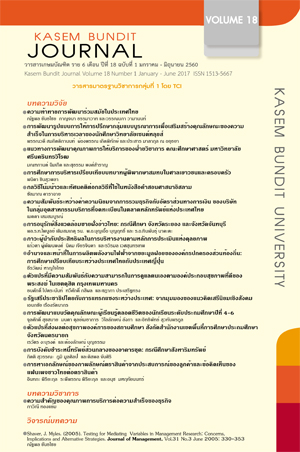กลวิธีโน้มน้าวและทัศนคติต่อกลวิธีที่ใช้ในหนังสือคำสอนศาสนาอิสลาม
Keywords:
กลวิธีโน้มน้าว, ภาษาโน้มน้าว, ทัศนคติต่อภาษา, หนังสือคำสอนศาสนาอิสลาม, hortatory strategies, hortatory discourse, attitudes to language, Islamic TextsAbstract
การวิจัยครั้งนี้มีวัตถุประสงค์สำคัญเพื่อศึกษากลวิธีโน้มน้าวและความคิดเห็นเกี่ยวกับกลวิธีโน้มน้าวที่ปรากฏใช้ในหนังสือคำสอนศาสนาอิสลาม ข้อมูลที่ใช้ในการวิเคราะห์จำแนกเป็น 2 ประเภท ได้แก่ ข้อมูลภาษาจากหนังสือคำสอนศาสนาอิสลามภาษาไทย และข้อมูลความคิดเห็นของกลุ่มตัวอย่างชาวไทยมุสลิมในกรุงเทพมหานครที่มีต่อกลวิธีโน้มน้าวในหนังสือคำสอนศาสนาอิสลามภาษาไทย สถิติที่ใช้ในการวิเคราะห์ข้อมูลคืออัตราส่วนร้อยละและค่าเฉลี่ย ผลการศึกษาเกี่ยวกับกลวิธีโน้มน้าวในหนังสือคำสอนศาสนาอิสลามปรากฏว่า กลวิธีโน้มน้าวสามารถจำแนกเป็น 3 ประเภท เรียงตามลำดับการปรากฏจากก่อนไปหลัง ได้แก่ กลวิธีทักทายผู้อ่าน กลวิธีดำเนินเรื่อง และกลวิธีแสดงความคาดหวังของผู้เขียน สำหรับผลการศึกษาเกี่ยวกับความคิดเห็นของกลุ่มตัวอย่างชาวไทยมุสลิมพบว่า กลุ่มตัวอย่างโดยรวมเห็นด้วยในระดับมากถึงมากที่สุดต่อกลวิธีโน้มน้าวที่ปรากฏใช้ในหนังสือคำสอนศาสนาอิสลามภาษาไทย
The main purposes of this research were to determine the hortatory strategies in Islamic texts in Thai, and to explore the respondents’ attitudes towards hortatory strategies used in Islamic texts in Thai. The data in this study derived from two sources, namely Thai hortatory discourse in Islamic texts, and Thai Muslim respondents’ attitudes towards language used in Islamic texts in Thai. The statistical analysis was descriptive. The analysis of hortatory strategies revealed that the main strategies of the Thai hortatory discourse consisted of three types, namely salutation, story telling, and the author’s expectations. The respondents’ attitudes towards the strategies used in Islamic texts in Thai, was rated between favorably and most favorably for salutation and story telling strategies in most cases.
Downloads
Published
How to Cite
Issue
Section
License
ทัศนคติ ความคิดเห็นใด ๆ ที่ปรากฏในวารสารเกษมบัณฑิตฉบับนี้เป็นของผู้เขียน โดยเฉพาะ มหาวิทยาลัยเกษมบัณฑิตและบรรณาธิการ ไม่จำเป็นต้องมีความเห็นพ้องด้วย







